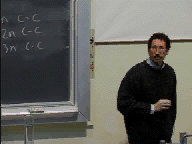Description
Many instructors have become far more satisfied with their SMET course simply by taking a few minutes during a typical lecture and posing a conceptual question called a ConcepTest to their students. Eric Mazur, a Harvard physics professor, developed this method for teaching undergraduate physics courses.1 These questions inform or calibrate students as to how well they understand what the instructor has identified as key ideas; and they calibrate instructors as to class mastery of these ideas at the time of their presentation. ConcepTests thus make the lecture a vehicle for bringing student and instructor expectations into alignment. ConcepTests are distinguished by a classwide vote-discuss-vote cycle built around a question that captures a key concept identified by the instructor. The format of a ConcepTest is shown schematically below, and illustrated in the following quick-time video clip:

(968k; click to view)

The ConcepTest process.
|
An example of a ConcepTest that could be used in a variety of SMET courses is the following:
|
If a blue solution cuts the amount of red laser light reaching a solar cell, which counts photons as photocurrent, in half...

What happens when a second identical solution is added?
|
Ask your class to vote: "How many of you think that a quarter of the laser light will now reach the solar cell?" (Pause to observe response by, e.g., show of hands.) "How many of you think none of the light will now get to the solar cell?" (Wait as before.)
If most of the class has correctly noted that one-quarter of the light will be transmitted, you can quickly affirm why this is correct and continue with the lesson. If the majority of the class does not select the correct answer, you ask your students to convince their neighbor(s) that their answer is correct. An option you might use is to give a hint, e.g., a reminder that each cuvette will transmit half of the light that enters it. After a short discussion period you have the class vote a second time. If the class has now selected the correct answer, a quick explanation is again appropriate; if the majority of the class has not reached the correct answer, a more detailed explanation can be presented. Sometimes the most effective ConcepTests are those for which the class has converged on an incorrect answer, as these questions identify a shared misunderstanding. Occasionally the class may even be thunderstruck by the correct answer, which, in this case, could be revealed by doing the experiment as a demonstration.
In general, ConcepTests can be used to strip a concept to a particularly simple case for analysis, to extend a concept in a new direction, to couple concepts, and to confront misconceptions, which can be folded into the possible answers to a ConcepTest. ConcepTests are often constructed to occupy the class for short periods of time, ranging typically from less than half a minute to several minutes. Judging when best to interrupt the discussion is an important and acquired skill. In most classes the noise volume will slowly build as students come to task, and then the volume will drop. The students' attention should be regained before the volume increases again; when this occurs, students have often moved on to other subjects.
With this non-graded, non-threatening format there is an opportunity for all students to discuss a concept with their classmates and to inform the instructor of the extent to which the concept is understood by the entire class. Because everyone is encouraged to participate, students are less fearful that their possibly incorrect answer will be publicly exposed to the entire class and thus are more likely to join in the discussion.
Assessment Purposes
- To obtain real-time feedback regarding student understanding.
- To determine the pace and direction of the remainder of the lecture.
Limitations
If the size of the class is too small (a dozen or fewer, e.g.), students may feel more conspicuous and self-conscious, hindering their participation. Instructors may need to encourage students to sit together to participate in ConcepTests if the lecture room has many more chairs than students; some instructors have grouped students into teams to work on ConcepTests during their lectures.
References
1. Mazur, E. Peer Instruction: A User's Manual; Prentice Hall: Upper Saddle River, NJ, 1997.
Tell me more about this technique:
Introduction
Description, Purpose, and Limits
Goals, Use, and Examples
Variations, Analysis, and Pro/Cons
Theory, Links, and Sources
Art Ellis, Clark Landis, and Katie Meeker
View Entire Technique
Download Technique
Tools

